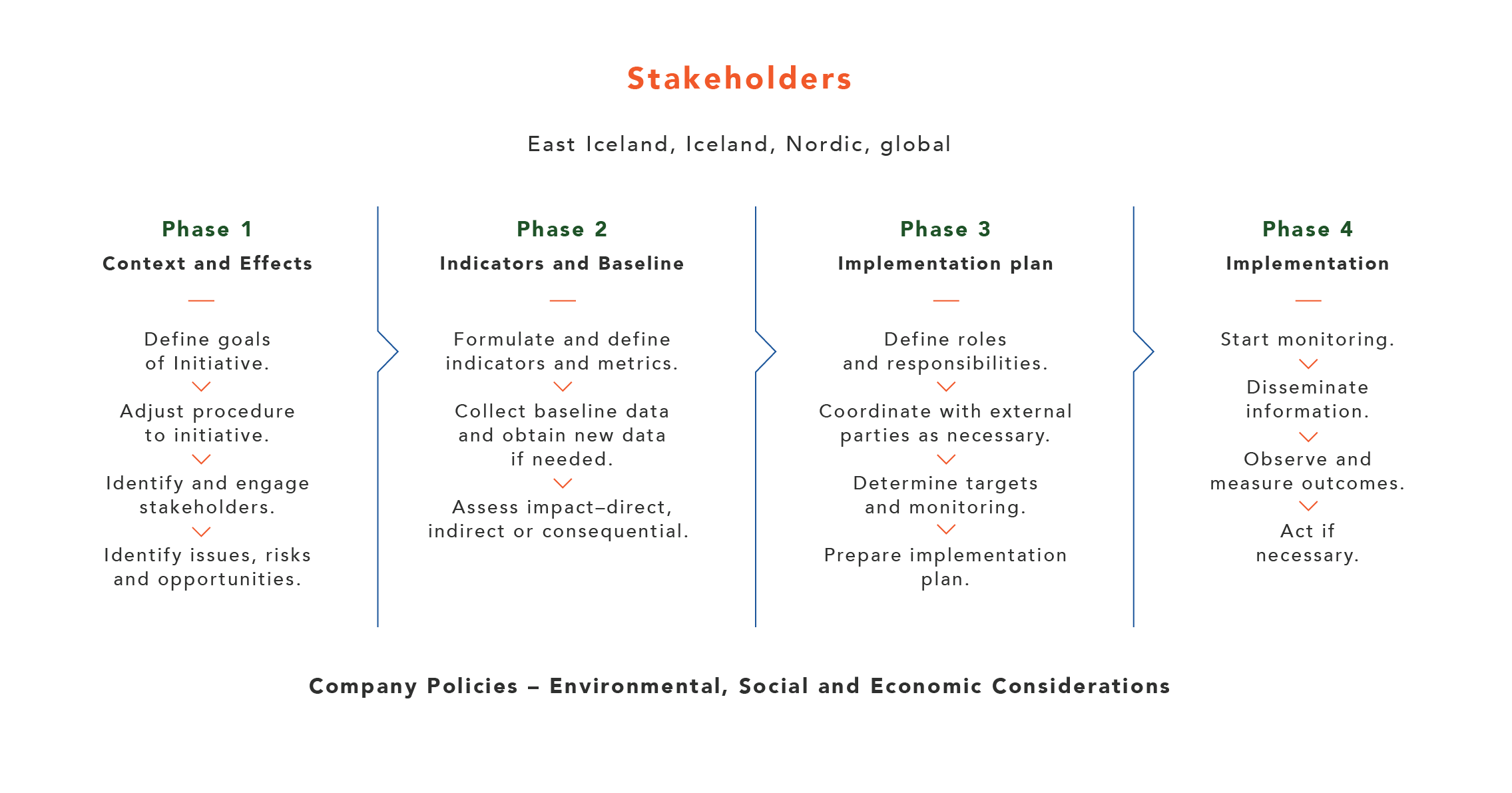Designing of the Initiative
Alcoa Fjarðaál and Landsvirkjun developed procedures based on the policies of the two companies concerning economic developments, the environment, and society. In every phase of the Initiative, stakeholders were consulted. The work procedure was divided into four phases (Figure 1), divided into several steps.
 Figure 1. Phases of the Sustainability Initiative
Figure 1. Phases of the Sustainability Initiative
Phase 1: Context and Effects
This phase laid the foundation of the Sustainability Initiative in that it delineated targets, enacted stakeholder cooperation, and pinpointed the main issues, whether involving opportunities or risks.
After being identified, stakeholders were brought into the spring of 2004 by summoning their representatives to a special Advisory Group. When selecting representatives for the Advisory Group, Landsvirkjun and Alcoa endeavored to achieve geographical distribution (with representatives from the East as well as other regions of Iceland); a balance of perspectives (e.g., on environmental factors, social factors, and economic factors); a combination of representatives from parties supporting and parties opposing the projects; and a mix of Group members from government bodies, social organizations, local authorities and the commercial sector. In addition, the Advisory Group had the mission of participating in the determination of sustainability indicators and metrics that would measure the effects of the companies' operations in East Iceland.
Two meetings were held with the Group, focusing on pinpointing the main issues and discussing the indicators and metrics. This phase was completed near the end of 2004.
Phase 2: Indicators and Baseline
Phase 2 involved determining statistical indicators and metrics and evaluating how the power plant and aluminum smelter might affect these indicators. Besides collecting existing information on the baseline circumstances, new data was obtained. Participants in the Advisory Group received a draft report on this material for comment and met for the third time to review it. When the Initiative was originally introduced, the assumption had been that the Group's task would end at this point, with the companies themselves fulfilling the roles of setting objectives and preparing an implementation plan. At the last meeting of the Advisory Group, however, those attending expressed a desire to continue participating in the Initiative and in consultation on setting objectives. Therefore, the second phase was concluded in 2005 by publishing the Report on Phases 1 and 2: Indicators and baseline.
Phase 3: Implimentation plan
This phase designated the roles of those responsible for implementing particular components of the Initiative. In some cases, the Plan had to be coordinated with the work of external parties. Numerical objectives or criteria were stated for each indicator, and both the monitoring approach and the means of preparing the implementation plan were decided. The fourth meeting of the Advisory Group was held to peruse the drafted objectives and implementation plan. The end of this phase was marked by issuing the Phase 3 Report in February 2006: Implementation Plan.
Work on the implementation plan involved the following aspects:
- Detailing the roles and responsibilities of individual parties regarding the Sustainability Initiative
- Talking to the parties who might be able to provide information on the indicators in which the impact of the projects is indirect or induced
- Determining the objectives and organizing the monitoring (in consultation with the Advisory Group and the pertinent experts in each case)
- Preparing a comprehensive implementation plan
Phase 4: Implementation
The monitoring program was launched during the early part of Phase 4: measurement data was logged, and the ongoing collection of baseline data was continued. However, when the indicators and metrics were examined, the premises for some of them had changed, while in other instances, the metrics had proved inapplicable. This meant that it was necessary to cancel, revise, or add indicators or metrics in some instances. All of the changes to the metrics and indicators can be seen here on this website, www.sustainability.is, which itself is part of Phase 4.
Monitoring formally began in conjunction with the meeting of participants in the Végarður community center on October 18, 2007.
